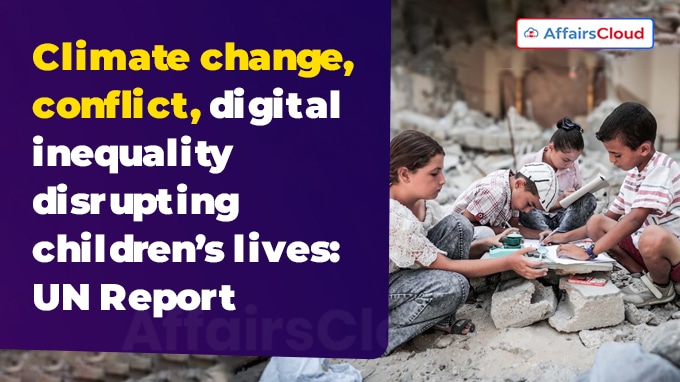 In January 2025, the United Nations Children’s Fund (UNICEF), a humanitarian aid organisation of UN released a report titled ‘Prospects for Children in 2025: Building Resilient Systems for Children’s Futures’. As per the report, climate change, economic instability, conflict and digital inequality are disrupting children’s lives and limiting their prospects.
In January 2025, the United Nations Children’s Fund (UNICEF), a humanitarian aid organisation of UN released a report titled ‘Prospects for Children in 2025: Building Resilient Systems for Children’s Futures’. As per the report, climate change, economic instability, conflict and digital inequality are disrupting children’s lives and limiting their prospects.
- The report warned that the coming year will witness a new and escalating period of crises for children worldwide.
- The report emphasized the urgent need to bolster national systems to protect children from global crisis and provide necessary support.
Key Findings:
i.Global Impact of Conflict on Children: As per the report, more than 473 million children i.e. more than one in six globally, lived in areas affected by conflict in 2023. The percentage of children affected by conflict has almost doubled, from around 10% (in 1990s) to almost 19%.
- The report highlighted that apart from risks to their lives, children face other risks such as: displacement, threat of starvation, disease and also substantial risks to their psychological well-being.
- The report observed that governments worldwide are finding it more difficult to finance important investments in children. This pressure reflects on various factors including consistent inflation effects, faltering development assistance and low revenues from domestic taxation.
ii.Children Living in Debt-Ridden Countries: The report revealed that nearly 400 million children live-in debt ridden countries, which hinders important investments in sectors like education, healthcare and social protection.
- The report noted that among the 34 African Union (AU) countries (as per the available data), 15 now allocate more to debt servicing than to education.
- Also, as per the World Bank (WB) estimates, each 5% increase in external debt in Low-and-Middle-Income Countries (LMICs) could decrease education expenditure by USD 12.8 billion.
iii.LMICs Spend More on Debt-Servicing than Crucial Sectors for Children: The report indicated that more than 40 LMICs spend double on debt-servicing as on health, for instance countries like: Indonesia (2.4 times as much), Pakistan (5 times as much).
- As per the report, debt service now consumes 11 times as much as social protection spending across developing countries, leaving 1.8 billion children exposed to economic shocks that push families deeper into poverty.
iv.Insufficient Climate Finance: The report showed that only 2.4% of multilateral climate finance is allocated to child-responsive initiatives, which support projects aimed at protecting children.
- This indicates that climate resilience of essential services for children is deteriorating.
v.Inequitable Access to Digital Services: The report highlighted the emergence of Digital Public Infrastructure (DPI), which is a set of shared digital systems that provide equitable access to public and private services.
- The report noted the persistent inequalities in digital access, particularly in Least-Developed Countries (LDCs).
- It showed that most young people from High Income Countries (HICs) have access to the internet, while only 53% of the youth (aged 15-24 years) have access to the internet in Africa.
- As per the report, adolescent girls are particularly affected, as are children with disabilities. It revealed that 9 out of 10 adolescent girls and young women (aged 15-24 years) have no internet access in LMICs.
vi.Economy: Economic prospects in emerging markets are discouraging, with growth well below the 7% target set in the Sustainable Development Goals (SDGs).
- A mix of pandemic scarring, climate shocks, and resource constraints means emerging markets’ growth prospects have fallen from historical averages of 5.6% to just 4% by 2026–2029.
About United Nations Children’s Fund (UNICEF):
Executive Director (ED)- Catherine Mary Russell
Headquarters- New York, the United States of America (USA)
Established- 1946
Member Countries- 190




